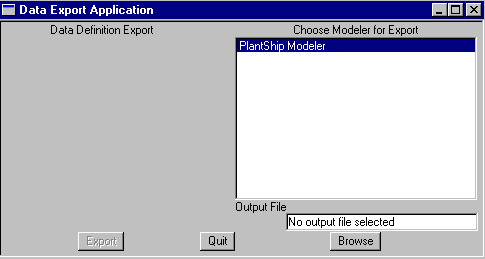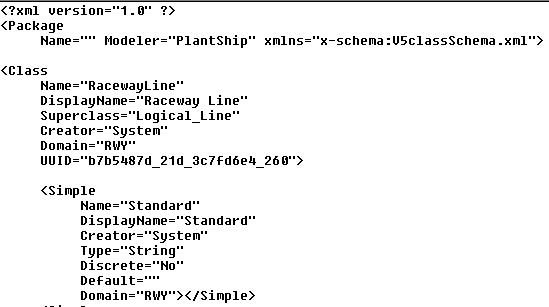Exporting V5 Feature Dictionary Data
|
|
This task shows how to export V5 Feature Dictionary data to XML format and make it available for comparison with the XML file of V4 Project Registration Model data. This process is also used when comparing two V5 feature dictionaries. | |
|
|
As part of the process of converting a V4
model to V5, you need to convert class and attribute data in a V5 Feature
Dictionary to XML format. The XML file will be placed in a specific
directory at a location where it will be available to your V5 applications.
When you use this command then all the feature dictionaries listed in your project resource management (PRM) file will be "exported" - in actual fact the classes and attributes they contain will be converted to XML format for further processing. To determine the location of the CATfct files, the application examines the entry "ImporterCATfcts" in the PRM file. This entry should indicate the location of your CATfct files. If left blank the default location is: ...intel_a\resources\graphic. The sample PRM files provided with this application are in: ...intel_a\startup\EquipmentandSystems\ProjectData. To determine which type of data is exported, the exporter program examines the value of the Visible field for each application in the PRM file. In the V4 to V5 Migration section of the PRM file there are resources named CATPiping, CATTubing, etc. If the value of the Visible field for these resources is No, then the data will not be migrated, if it is Yes, it will be migrated. This step is not needed if you did not define new classes and attributes in V4. |
|
|
|
1. | Change to the directory ...intel_a\code\bin
at a command prompt and take the following steps:
If you changed the location of your installation execute: set CATDisciplinePath=XXX\startup\EquipmentandSystems\ProjectData (see note below) set AECMIGR_PROJECT=Project where XXX is the directory path to your installation. If you want to use a PRM file with a name other than "Project" then change the word "Project" to the name of your file (AECMIGR_PROJECT=XXX). Execute: catstart.exe -run CATAecDictionaryExporter.exe -env Environment_name --direnv ...\application data\ DassaultSystemes\CATEnv .
After you execute the command, the Data Export Application dialog box displays. |
| 2. | The Choose Modeler for Export window displays all the modelers available to you. Simply put, a modeler contains the list of applications whose CATfct files will be exported. The PlantShip Modeler seen here includes all plant-ship applications as of R10. Select the modeler you need. Even if an entry is highlighted, as in the image above, you should click on it. | |
| 3. | In the Output File field browse to or enter the directory path and name of the file where you want the XML output to be placed. If you select an existing file then it will be overwritten. If you enter the name of a file that does not exist then a new file will be created. | |
| 4. | Once you have filled in these fields the Export button will become
available. Click on it to generate the XML content. A message will inform
you when the process is complete. The image below shows an excerpt from a
generated XML file.
|
|
| 5. | Click Quit when you are finished. | |
|
|
The next step will be to compare the classes and attributes contained in the V4 and V5 XML files. | |
|
|
||

